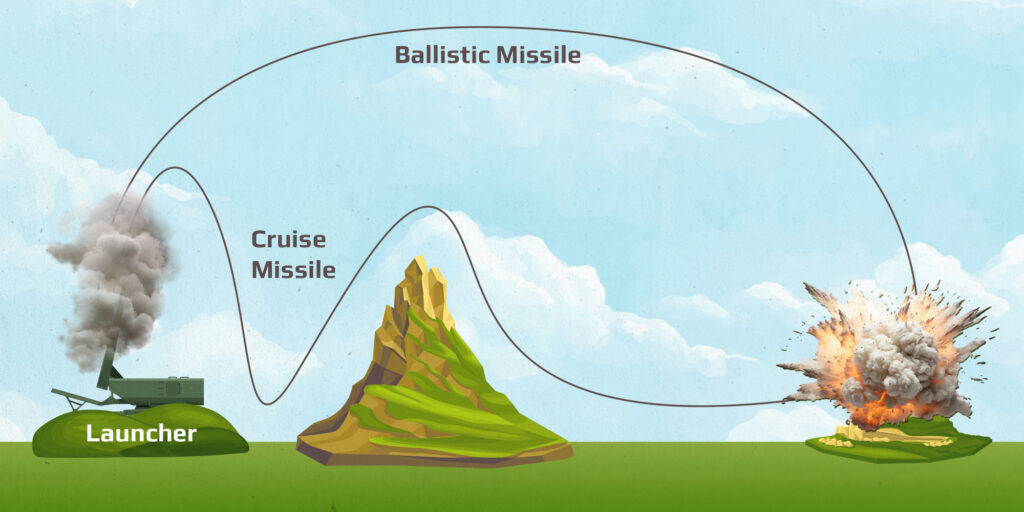During the 94 weeks of the full-scale invasion, Ukrainians have already managed to get used to air alarms and subsequent explosions. But lately, the opposite has been happening more and more often: explosions are heard even before the alarm turns on. This happens when the aggressor starts firing ballistic missiles at us. With the available technical resources, we cannot cope with this disadvantage of the warning system, although the Ukrainian air defense (air defense) manages to shoot down missiles of this type quite well. What’s this all about?
Until the spring of this year, cruise missiles were the main means of air attacks on Ukrainian cities, most of which were “Kalibr” missiles. They are launched mainly from ships or aircraft-launch vehicles, and they fly slower than the speed of sound in the air (1235 km/h), most of the way keeping a speed of 270–280 m/s (970–1000 km/h), for which their engines are constantly turned on at almost full power. And although, in order to reduce the chance of radar detection, their flight takes place at a low altitude, Ukrainian defenders still notice most of them on long-range approaches to territorial waters or controlled territory. Most often, enemy missiles have 7–10 minutes left to fly to major cities, except Kharkiv, Kherson and Zaporizhzhia. Radar data is transmitted first to the operators of anti-missile systems and then to the warning system, which includes an air alarm signal. Its response time is 2–3 minutes, which in this case is generally enough to take some measures.

Moreover, over-the-horizon radar can even detect takeoffs of aircraft from which missiles are launched. Then we will receive a warning almost half an hour before a possible hit. Although in this case, the alarm may be false if the aircraft does not fire a single missile. This has also happened many times.
However, starting around May, the enemy has been increasingly using ballistic missiles, mostly ground-based. It is much more difficult to find a relatively small launcher somewhere in the forest at a distance of 100–200 km from the border than an aircraft or a ship, and it is also very difficult to notice a launch from it. The engines of such rockets generally work only during the initial part of the flight. Soldiers of the air defense system have to “catch” them on the way to the target. The easiest way to do this is with the infamous “Kinzhal”, a hypersonic air-launched ballistic missile. At one time, their shooting down over the Kyiv region was an unpleasant surprise for the Russian leadership and designers of rocket technology.

But the key issue here is speed. For ballistic missiles (for example, the most famous Iskander-M), it is more than 2000 m/s, or almost 7.5 thousand km/h. This means that in a minute, taking into account the inclination of the trajectory, they cover about 100 km. Recall that the distance from Kyiv to the nearest point on the territory of Russia is less than 200 km. Due to the fact that a missile of this type passes a significant part of the way at high altitude, radars “see” it at a greater distance, but nevertheless, a maximum of three minutes will pass from the moment of detection to defeat by air defense systems (in the worst case, hitting the target). This is enough to activate, aim and launch anti-missiles, but the missile attack warning system works significantly slower, turning on the siren after we hear the bombing “with our own ears”.
Is it possible to eliminate this design flaw? Perhaps it is possible — by improving the software as well as using more efficient means of computing and communication. But then we will face another limitation: the speed of a person’s reaction to an attack message. How many people will have time to get dressed in a couple of minutes, leave the house and run to the bomb shelter? Even with a cruise missile attack, not everyone succeeds. Of course, in such cases, even a minute’s grace time is absolutely not superfluous. Although, it would be much better to increase the effectiveness of missile defense, which would allow intercepting ballistic missiles at a higher altitude and distance from the target. Of course, Ukrainian designers and specialists from the allied countries are already actively working in this direction, but we will most likely find out the results of their work after the end of the war…
Earlier we wrote about the principle on which the engines of modern rockets were based.
Follow us on Twitter to get the most interesting space news in time
https://twitter.com/ust_magazine


